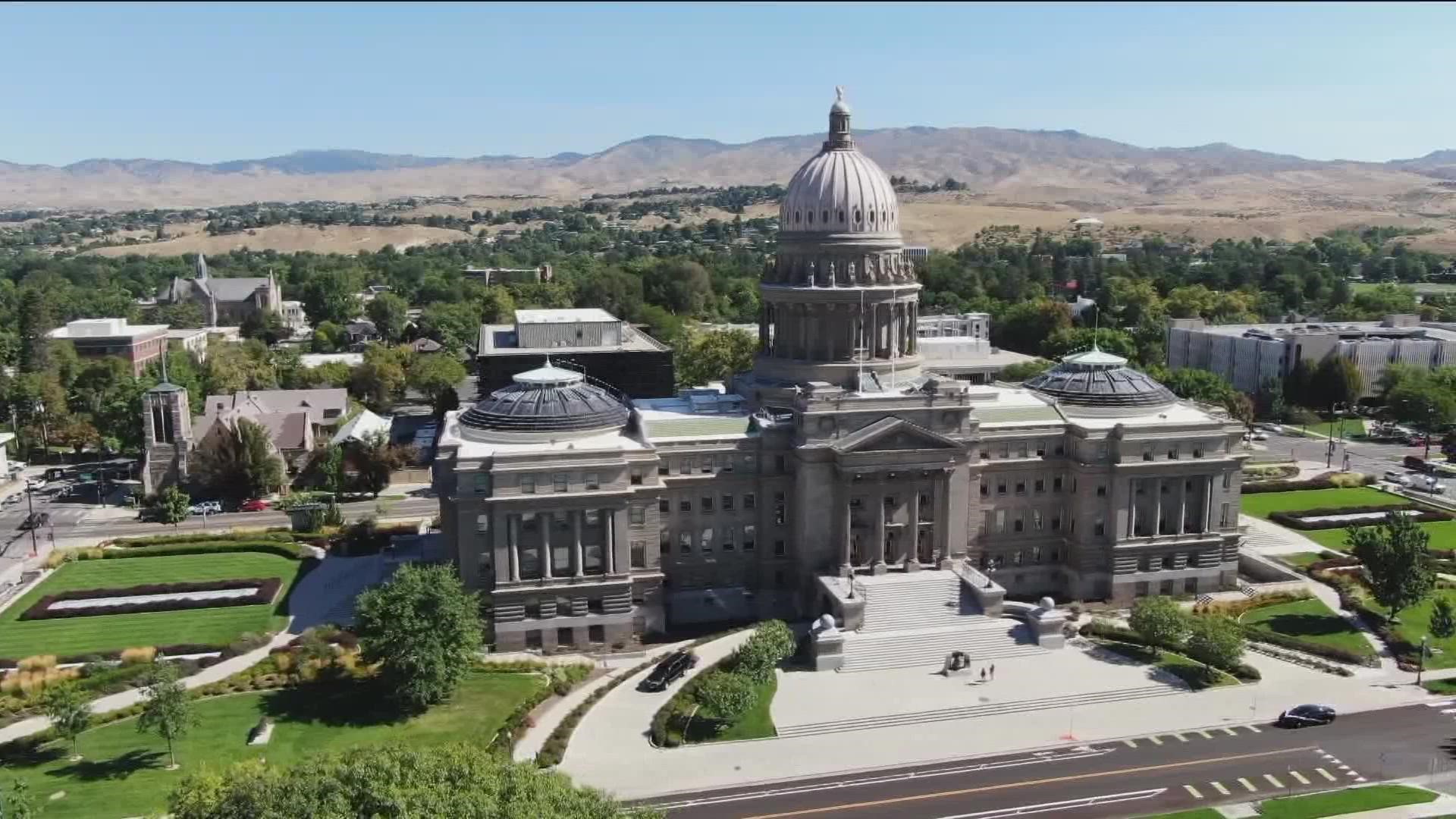BOISE, Idaho —
This article originally appeared in the Idaho Press.
The Hercules C-130 aircraft descended to an altitude of 150 feet, releasing 3,000 gallons of water over a grassy landscape.
The water drop took place near the Boise Airport’s third runway, south of Gowen Field, and was part of a weeklong training involving four Air Force Reserve units, or wings, and federal agencies that work to support wildfire suppression efforts around the country. When fighting fires, the plane would drop fire retardant.
“We conduct this training annually because it gives us an opportunity to work with our military partners and ensure they are ready to be integrated into our fire suppression operations in a safe, effective, and seamless manner should the need arise in 2022,” said Kim Christensen, deputy assistant director for operations for the Forest Service at the National Interagency Fire Center, located in Boise.
The training is part of a series of events in May to prepare for fire season and is among a growing local and regional effort to mitigate wildfires.
MAFFS PLANES DEPLOYED ON AN AS-NEEDED BASIS
The training is part of the Modular Airborne Firefighting Systems program, or MAFFS. The four Air Force Reserve wings participating are the California Air National Guard’s 146th Airlift Wing, the 302nd Airlift Wing from Petersen Air Force Base, Colorado, the Nevada Air National Guard’s 152nd Airlift Wing, and the Wyoming Air National Guard’s 153rd Airlift Wing. Each wing has two of the Hercules C-130 planes, for a total of eight aircraft capable of transporting the fire retardant to where it is needed.
The MAFFS planes are only activated when all of the commercial airtankers that are part of the national airtanker fleet are “fully committed or not readily available,” according to a press release about the event.
Last year, all eight of the aircraft were activated during the second-busiest fire season in the program’s 49-year history, said Lt. Gen. Kirk Pierce, commander with the U.S. Air Forces Northern, in the release.
The need for MAFFS support tends to arise during peak fire season, Christensen said. This often happens during the second half of July through the first half of September, when there are multiple regions of the country experiencing “elevated fire activity,” she said. At that point, one or more of the MAFFS planes can be activated from a specific location to tamp down fires there.
A MAFFS operation includes one of the Hercules C-130 planes, as well as other support elements, such as a lead plane. It is easiest to base all of the MAFFS operations in the same location, and they can then increase or decrease the number of operations in that location, Christensen said.
The lead plane flies over an affected area to confirm the location where ground personnel are requesting the retardant drop, said a spokesperson at the event. Lead planes are smaller and more nimble than the C-130s, allowing them to assess conditions, such as wind speed or air pressure. Afterward, the lead plane and the C-130 plane do what is called a “show me” pass: the lead plane escorts the C-130 plane over the site where the retardant will be dropped. On the next pass, the lead plane leads the C-130 back to the target site to drop the retardant.
It is accepted that wildfires are increasing across the western U.S., said Lt. Col. Jesse Newberry, a pilot in the 302nd Airlift Wing. Many of the people who fight fires live in areas that are also at risk of wildfire, he said. A few years ago, he and others had to fight fires that threatened their own neighborhoods in Colorado Springs, he said.
“It’s a big deal,” Newberry said. “I wish it wasn’t so, right? We wish we didn’t have to do it. But yeah, it seems like it’s getting a little more significant.”
WILDFIRE IN IDAHO COULD IMPACT MORE PEOPLE
Idaho encompasses two geographic areas prone to wildfire: a high desert sage brush environment in the southern portion of the state, and a mountainous, timber-dominated landscape in northern part of the state, said Tony Piscopo, the city of Boise’s Wildlands Division chief.
Historically, Idaho's wildfires burned in areas without large populations, he said. But that could be changing with more people moving to the state, he said.
“As more people move in and move out into the (Wildland Urban Interface), I think you’re going to start seeing an increased number of folks affected by wildfire,” Piscopo said.
A Wildland Urban Interface, or WUI, is the “zone of transition between unoccupied land and human development,” according to the U.S. Fire Administration.
In Boise, that interface is defined as north of Hill Road and north of East Warm Springs Avenue, Piscopo said, though there are pockets that are vulnerable to wildfire outside of those areas, he said.
Increasingly, high winds are the driving force behind where wildfires occur, and it is not always limited to a city’s designated WUI, Piscopo said. In the summer of 2021, 90 mile-per-hour winds tore through an area of Boulder, Colorado, outside of the city’s WUI, fueling a fire that impacted 1,600 homes, Piscopo said. That area does not typically see winds of that speed, he said.
Even calmer, less windy conditions can pose a threat with high temperatures in play, Piscopo said. Both scenarios create conditions that are hazardous to firefighters, he said.
CITY OF BOISE MAKING STRIDES TO PROTECT PEOPLE AND HOMES
There has been a push for entities at all levels to adopt fire mitigation strategies, Piscopo said. In 2018, the city of Boise and the Boise Fire Department formed a wildfire division to begin making strides toward better protecting people and homes from wildfires, Piscopo said.
The city has created a “WUI code” or a designation of how homes in the WUI can be built, including the types of building materials, he said.
The city works to reduce fuels on city lands through mowing and the removal of invasive species that could fuel fires, Piscopo said. There is also a plan in development to use controlled burning, also known as prescribed burning, to make areas less susceptible to wildfire, but that is likely a ways off, Piscopo said.
Homeowners and residents can access resources through the Ada Fire Adapted Community website (AdaFireAdapted.org), he said. One program is known as Code Red, which invites homeowners to sign up for emergency notifications. It is part of a larger program called “Ready, Set, Go!” which encourages homeowners to harden their home to wildfire, make an emergency evacuation plan, and evacuate if necessary.
Another program offered by the city is a free wildfire home safety evaluation for people living in the WUI to learn about reducing wildfire risk on their property, he said. This often includes reducing brush and ensuring there are not flammable fuels within five feet of the home, he said. Homeowners are eligible for a free chipping service for the flammable vegetation they gather from their property, he said.
Inspectors may also point homeowners toward fire resistant roofing and vent materials to better protect their home from a fire, he said.
However, even mitigation is not completely fail-safe, Piscopo said. This is because mitigation recommendations tend to accommodate for “normal” fire conditions, which don't always account for less common, wind-driven fires, such as what happened in Boulder last summer, Piscopo said.
But it is still important for residents to make an effort to mitigate risk where they are. It’s similar to flood risk — even if a resident lives in an area that is unlikely to flood, they should still take the precautions they can in case the extreme happens, he said.
BOISE’S HOME INSPECTIONS ARE NOT MANDATORY
In parts of California, people who live in designated WUIs are required to have a home inspection and follow the recommendations given to them to mitigate their wildfire risk each year. The city of Boise’s program is free to those in Boise’s WUI, but they are not required, Piscopo said.
One reason those kinds of inspections are required in parts of California is because those areas have burned before, and as a result, insurance companies want homeowners to do the inspection before they will provide insurance, he said.
Given that the city already is requiring homes being built in the WUI to be built to a certain standard, he does not foresee the city requiring wildfire related home inspections unless it was driven by insurance, he said.
“So hopefully, and I think the city is forward-thinking enough that we’re putting as many things out there for the homeowners and making them available, that they take us up on what we’re offering before anything would have to become mandatory,” he said.
This article originally appeared in the Idaho Press. Read more at the IdahoPress.com
Watch more Local News:
See the latest news from around the Treasure Valley and the Gem State in our YouTube playlist:



